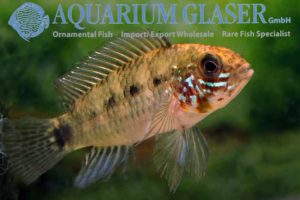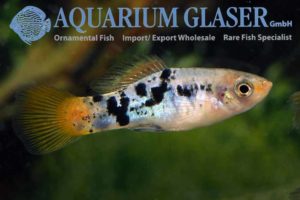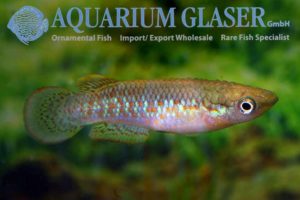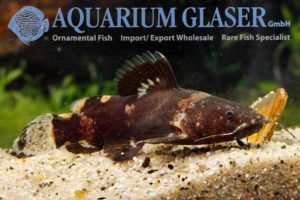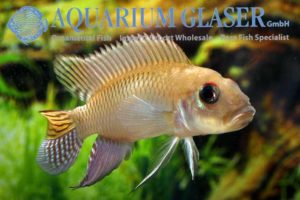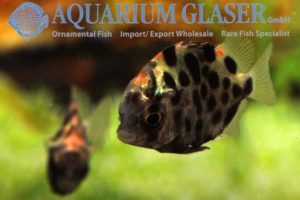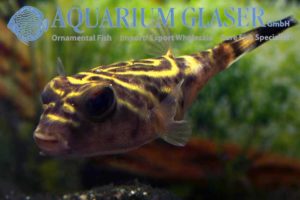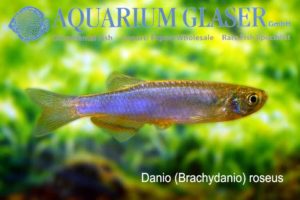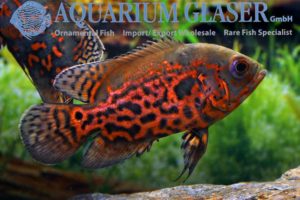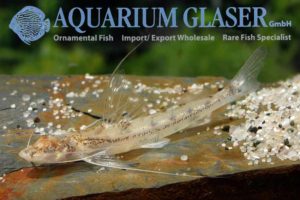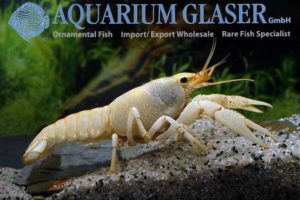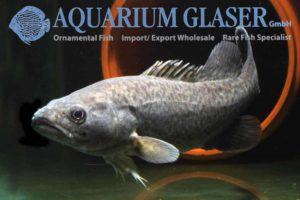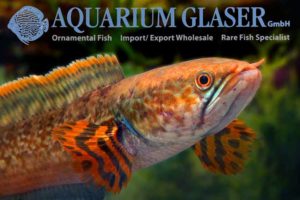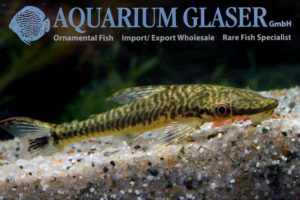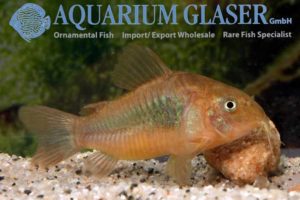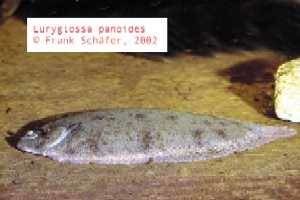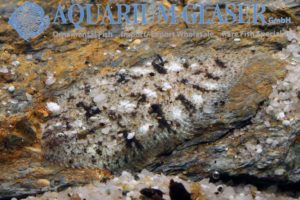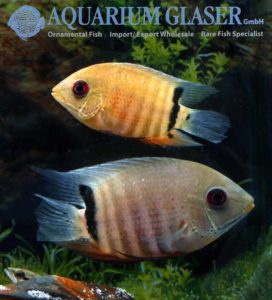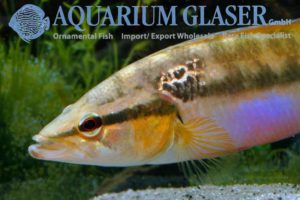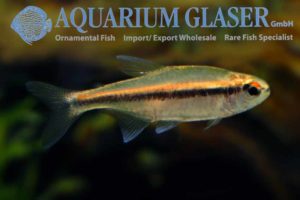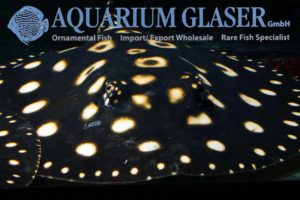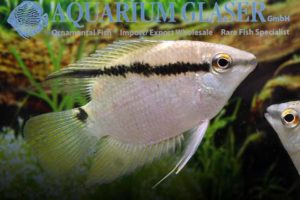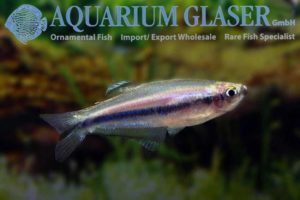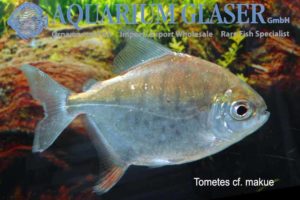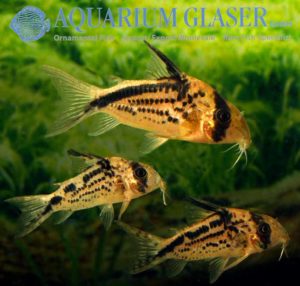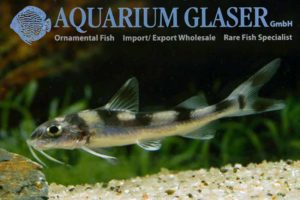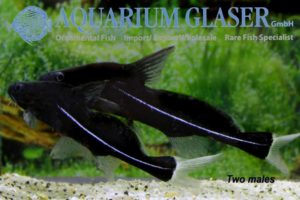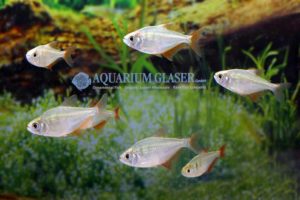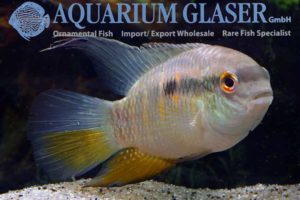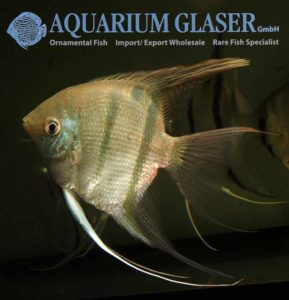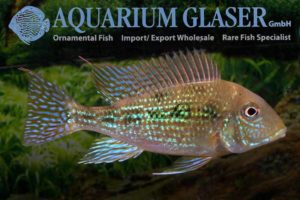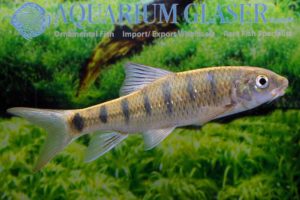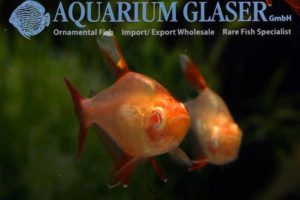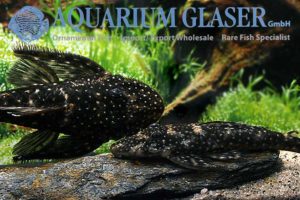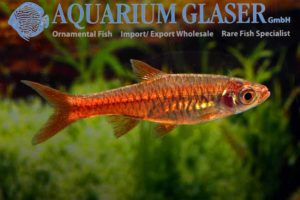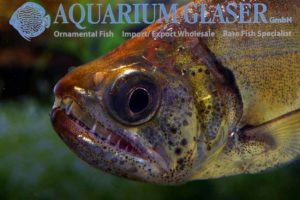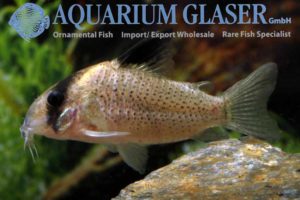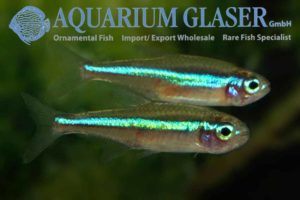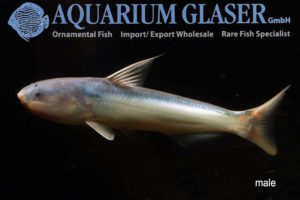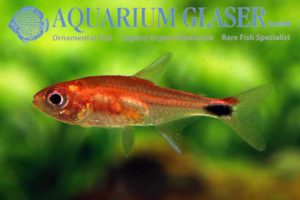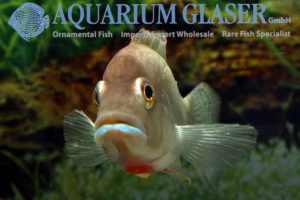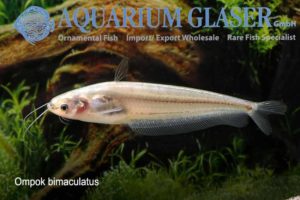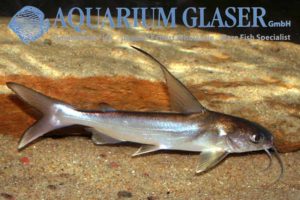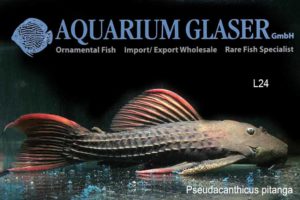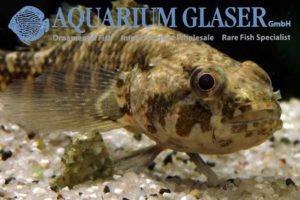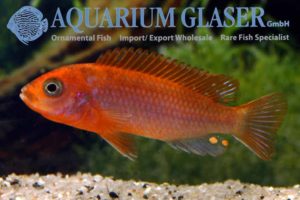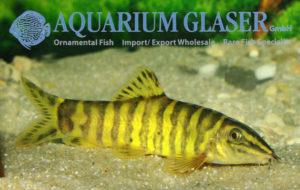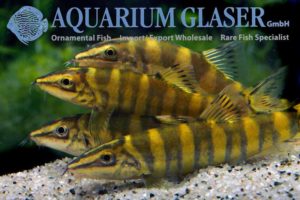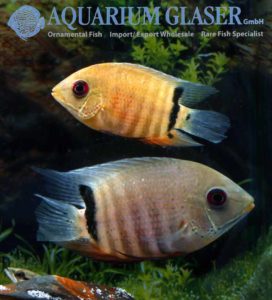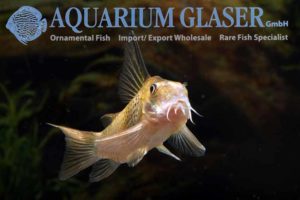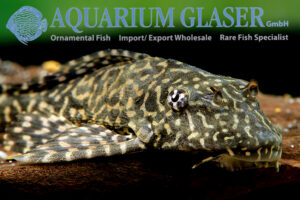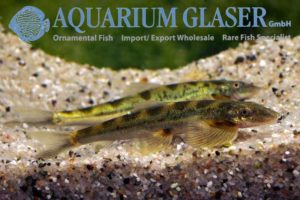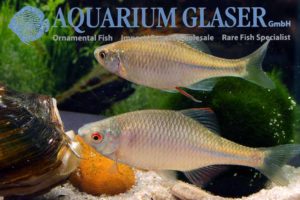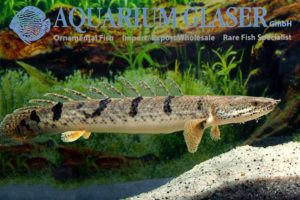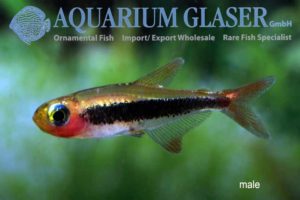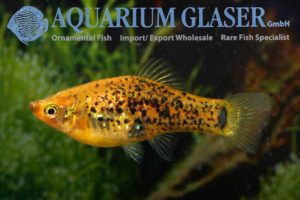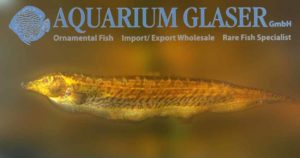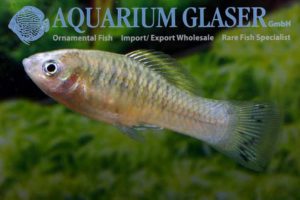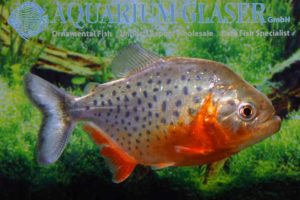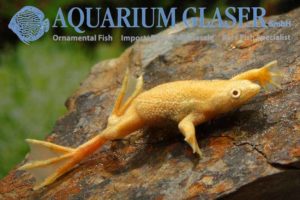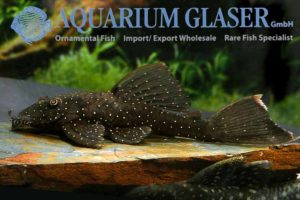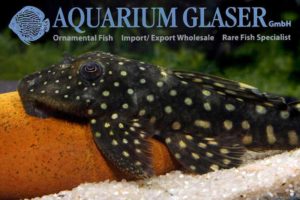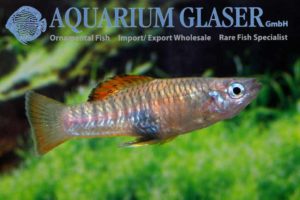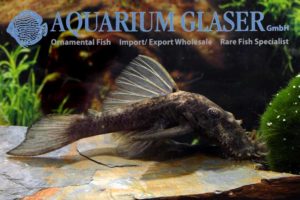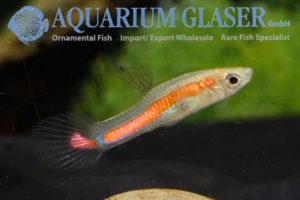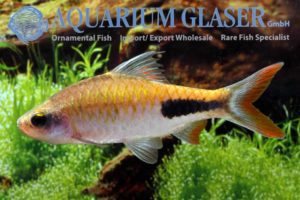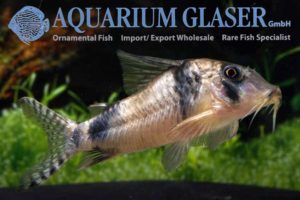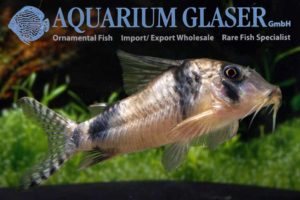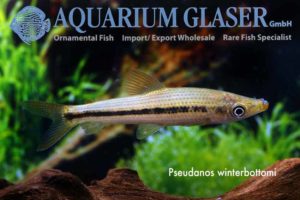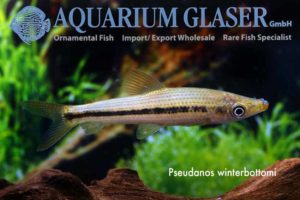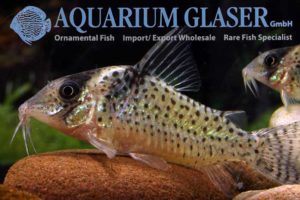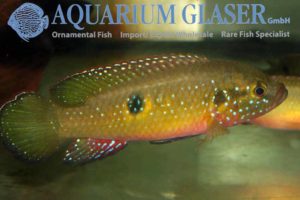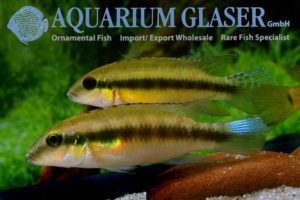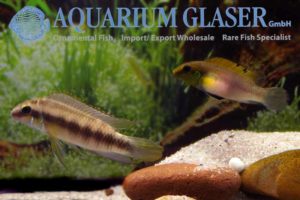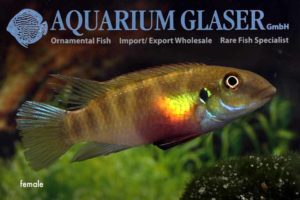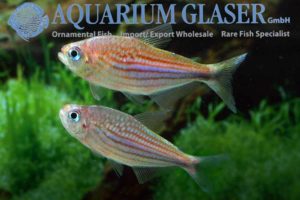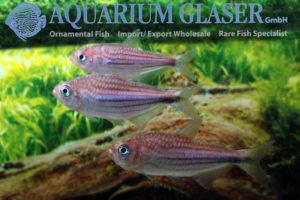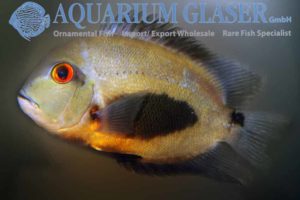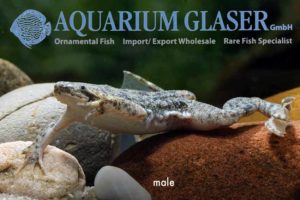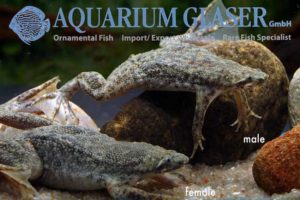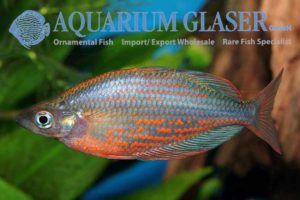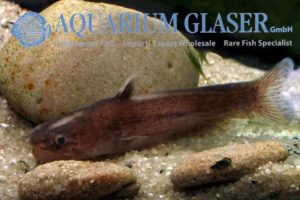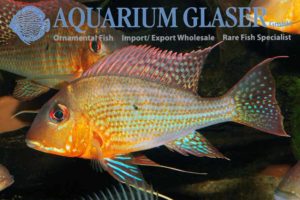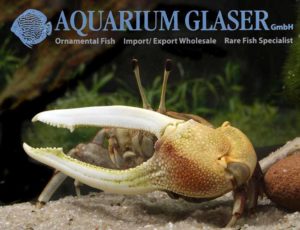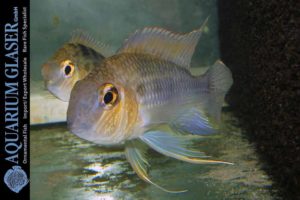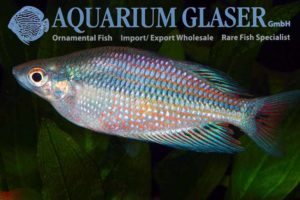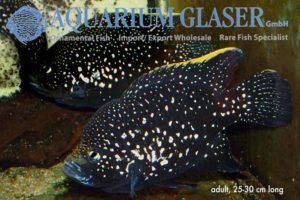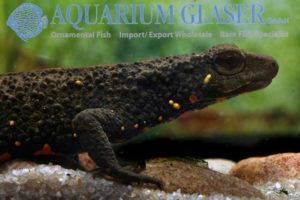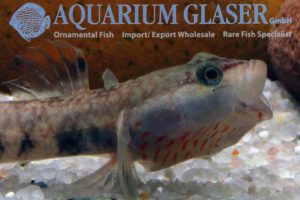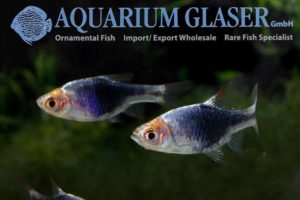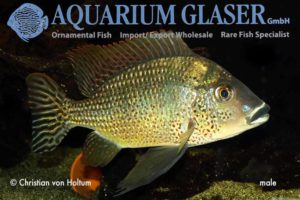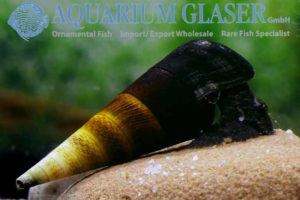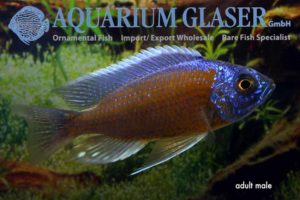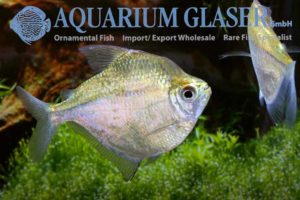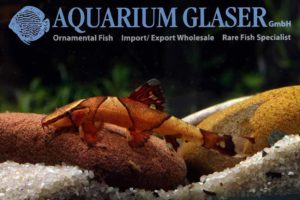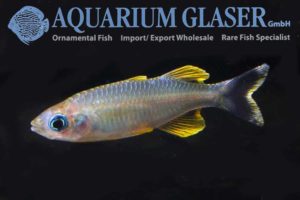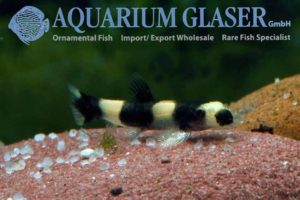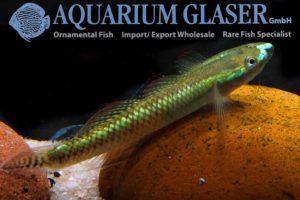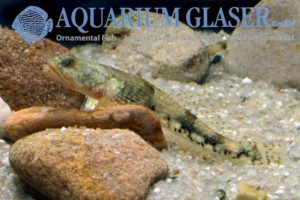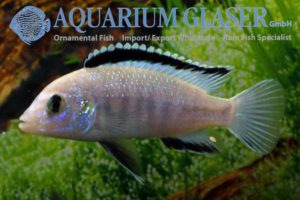The species Apistogramma commbrae is only very occasionally available. The species has been described back in 1906 already and has a very wide distribution: Argentina, Brazil, and Paraguay. But from this region mainly the close relatives of A. commbrae, namely A. borellii and A. trifasciata become exported. This is not easy to understand, because A. […]
Fish Archive (3137)
-
-
Xiphophorus variatus Rio Nautla
We obtained in very limited numbers this beautiful local variety of the wild variatus platy (Xiphophorus variatus) from a German breeder. The Rio Nautla variety is a fish that occurs in the wild, not an artificial sport! For our customers: the fish have code 442983 on our stocklist. Please note that we exclusively supply the […]
-
Pachypanchax playfairii
Aquarists who like to read in elder books find this killifish in all literature until the 1970ies: the Golden Panchax, Pachypanchax playfairii. Then the species seems to have disappeared from the aquarium hobby mainstream. By the way: the Golden Panchax is the only primary freshwater fish species from the Seychelles. The Golden Panchax belongs to […]
-
Batrochoglanis raninus Dwarf
Batrochoglanis raninus Dwarf The genus Batrochoglanis was formerly placed in Pseudopimelodus. Batrochoglanis can be best distinguished from Pseudopimelodus by the shape of the caudal fin. Pseudopimelodus has a deeply forked caudal fin, Batrochoglanis only a slightly indented one. Currently five species of Batrochoglanis are accepted. We obtain occasionally specimens of that genus from Colombia, which […]
-
Nanochromis parilus
Nanochromis parilus is a species of dwarf cichlid that originates from the Congo region. Usually we offer this species as wild collected ones. But currently we found a breeder that can supply us with fully grown, very healthy, gorgeous animals. It is quite interesting that among these bred fishes two types of males appear. Some […]
-
Scatophagus
Tiny scats Scats (Scatophagus) spawn in the sea. The juveniles enter brackish water zones after their development in the plankton. From the mouths of the rivers they migrate often far inland. In India currently this migration starts and we received from there charming scat babies of 1-1.5 cm length. Juvenile scats show their realtionship: the […]
-
Sphoeroides annulatus
A very interesting species of pufferfish reached us currently from Colombia: Sphoeroides annulatus. This species is primary a seawater fish, but juveniles are often found in pure freshwater. However, we recommend to keep the species in brackish water. This beautiful puffer can reach a maximum length of 40 cm. Most specimens are peaceful, but one […]
-
Danio (Brachydanio) roseus
The pearl danio (Brachydanio albolineatus) is the type species of the (sub-)genus Brachydanio. It belongs to the most popular species of ornamental fish in the world and is almost anytiome available in any petshop. However, the other Bracydanio in the closer sense are by far less well known. Among them is Brachydanio roseus that originates […]
-
Astronotus ocellatus Roter Tiger Oskar
Only a Red Tiger Oscar… The man-made sport “Red Tiger Oscar” from Astronotus ocellatus is very common in the ornamental fish trade. Oscars are large cichlids that should be kept only in really large tanks. Here they are very nice pets with a great personality. However, we often do not look very intensive on such […]
-
Mastiglanis asopos
Catfishes in general often look quite odd. This is for sure true for this dwarf catfish, which was described only in 1994 in a new genus. The maximum length of this fish is about 6-7 cm without the caudal fin. The shape of the body is very elongate. The extremely long pectoral fin rays are […]
-
Procambarus clarkii White
The Louisiana crayfish (Procambarus clarkii) has become a real domesticated pet. Quite a lot of colour sports have been developed by breeders. These sports do not exist in the wild. One of these sports is plain white. In case the female bears eggs it looks like Snow White playing with snowballs… Sadly the species P. […]
-
Maccullochella peelii
Who ever looked for a really extraordinary fish as a pet will find it in this species. M. peelii is the largest freshwater fish of Australia. The popular name of Maccullochella peelii is “Murray Cod”, after the Murray River. The average length of adults is about 60 cm and 2-3 kg weight; but the largest […]
-
Channa sp. aff. bleheri “Flame Fin”
A really gorgeously coloured dwarf snakehead reached us from the foot of the Himalaya. Our specimens are obviously fully grown adults and have about 12 cm total length. Compared with all other dwarf snakeheads of that relationship in our fishhouse – Channa gachua, Ch. sp. Fire & Ice, Ch. bleheri, Ch. andrao, Ch. sp. Laos […]
-
Hypoptopoma cf. psilogaster “sp. II”
The dwarf catfish of the genus Hypoptopoma are close relatives of the much better known Otocinclus species. Both genera have a similar habit and a similar way of life. Members of Hypoptopoma have a very typical position of the eyes. This gives them the advantage to be able to see what happens below them them […]
-
Corydoras aeneus Cuiabá
The Bronze Cory is the most popular and most widespread Corydoras in the hobby. This stands in a strong contrast to the scientific knowledge about the systematics of that species. From a systematist´s point of view the Bronze Cory is among the least understood species of the genus. Currently only one species is accepted, which […]
-
Euryglossa panoides
Flounders and tongues belong to a group of fishes that are rarely seen in the aquarium hobby. Whereas flounders have a well developed, clearly visible caudal fin, in the tongues the dorsal, ventral and caudal fins are melted. The species Euryglossa panoides, which is by chance imported from India and Vietnam belongs to the tongues. […]
-
Euryglossa panoides
Many species of flatfish (of course not all of them) are wanderers between two worlds. They are very tolerant against different salinities and can live as happy in pure freshwater as in pure marine water. The common European Flounder (Platichthys flesus) for example is found occasionally as far upwards as Basel in the Rhine. However, […]
-
The mouthbrooding Heros from Venezuela: a new species! Heros liberifer
At least from 1992 on Heros have been exported from Venezuela that were thought – according to scientific and hobby publications – to belong to the species Heros severus Heckel, 1840. In 1994 the aquarium community learned fascinated the fact that these “real” H. severus (all other Heros in the hobby belong to different species […]
-
Crenicichla edithae
We received this beautiful, medium-sized (around 15 cm) pike cichlid from Paraguay. Our fish represent the form that is depicted as Crenicichla cf. edithae in Stawikowski & Werner (2004: 140). Occasionally Crenicichla edithae is regarded as a synonym of C. lepidota. C. edithae has been described scientifically in 1991 by Alex Ploeg for his wife […]
-
Hyphessobrycon vilmae
The “chocolate neon tetra”, Hyphessobrycon vilmae, originates from the upper reaches of the Rio Tapajós in Brazil. Sadly it only rarely available. Regarding keeping not much is to say here: the fish requires the very same conditions as the well known “black neon tetra”, Hyphessobrycon herbertaxelrodi. The males of H. vilmae have a more intensive […]
-
Potamotrygon leopoldi Black Diamond German Bred
We received extremely beautiful German bred Black Diamonds. Moreover the fish are sorted by pair! The Black Diamond is a variety of Potamotrygon leopoldi that originates from the upper Rio Xingu in Brazil. These splendid stingrays attain a maximum size of about 40-60 cm disc width. One should never forget that the poison of these […]
-
Mesonauta acora Tocantins
We receved very interesting and very pretty flagcichlids (Mesonauta) from the Rio Tocantins in Brazil. A very special feature of these fishes is the fact that the basic pattern is extremely variable. Usually this dark basic pattern, which is shown by the fish mainly when they are stressed or excited, is species-specific. However, in this […]
-
Mimagoniates barberi
Sadly we are only very occasionally able to import this beautiful blue tetra from Paraguay: Mimagoniates barberi. But now we finally can offer once more this very lively brook fish. Our wild collected fish seem to be fully grown; at least they are sexually ripe. The males (about 4 c, total length) are larger and […]
-
Tometes cf. makue
Luckily we were able to import several times the beautiful Myleus schomburgkii “Broadband” this season already. The fish originate from Venezuela. Only me, the chronicler, did not find the time yet to make a photo in a photo-tank, so we add here “only” a picture we made in our fishhouse. The most current importation contained […]
-
Corydoras loxozonus
This cory belongs to the most attractive members of the genus Corydoras and is also very easy to keep. One should only remember that C. loxozonus – it originates from the Rio Orinoco and its affluents – prefers higher temperatures. So the water temperture should not sink below 25°C for longer. Currently we can […]
-
Gagata cenia
The Assamese Clown Catfish is the perfect choice for all aquarists that love lively species. This catfish attains a maximum length of about 15 cm, but matures at a length of less than 7 cm. The fish is a real energy pack. It can be hardly ever found resting for a minute, it is always […]
-
Bagrichthys macracanthus
Currently we can offer a very seldom imported, unusual catfish from Southeast Asia (eastern Sumatra): Bagrichthys macracanthus. This catfish attains a maximum length of about 20 cm. In the wild, the species inhabits river portions with only very low current. Against conspecifics males are quite quarrelsome; kept by pair or in groups composed of one […]
-
Gymnocorymbus socolofi
It´s been quite a long time that we were able to import this pretty tetra – Gymnocorymbus socolofi – from Colombia. Very small specimens look very much alike the Yellow Tetra (Hyphessobrycon bifasciatus), but the larger they grow the more the shape of the body becomes alike a Gymnocorymbus. Finally we received the pretty orange […]
-
Laetacara fulvipinnis
Only very rarely this beautiful dwarf cichlid becomes imported. Nevertheless it is known in the hobby for quite a long time. Since 1978 it was named “Aequidens sp. Orange Fin”, later, after the splitting of Aequidens and Laetacara in separate genera, Laetacara sp. “Orange Fin”. The scientifical valid description appeared only in 2007, when Staeck […]
-
Pterophyllum “dumerili”
Pterophyllum “dumerili” We received really breathtaking beautiful angels belonging to the species Pterophyllum leopoldi, among them animals in show-size. On our stocklist the fish are named P. dumerili. Although we know of course that – technically speaking – P. dumerili is only a synonym of P. scalare and our fish belong to the properly described […]
-
Geophagus mirabilis
This beautiful species of eartheater is known in the aquarium hobby since the year 2009. It is endemic in the Rio Aripuana. So it was called initially Geophagus sp. “Aripuana”. The scientific description of the species appeared much later, in january 2015. Now the correct scientific name is Geophagus mirabilis. The specific name, mirabilis, means […]
-
Acrossocheilus paradoxus
We received this interesting fish from Taiwan. It can be kept as well in unheated aquaria as in garden ponds. The species usually attains a length around 12 cm. This means that our specimens are adult already. Maximum size recorded is around 20 cm. Males have a by far larger anal fin than the females. […]
-
Megalamphodus sweglesi Albino
For the first time ever we obtained from our breeder the albino sport of that fish. Independent of the question wether one likes albinos or not: the somewhat spooky fish deserve the common name Red Phantom Tetra rather than the wild type. And for sure friends of artificial sports will love this new one! For […]
-
Flyer-cats from Brazil!
Recently we received a shipment of flyer-cats (Pseudolithoxus), which have been collected in the surroundings of Sao Gabriel do Cacheiro at the Rio Negro. At the first glimpse the fish look very similar to P. anthrax (L235) from Venezuela. But they are distinguished from the latter by the much larger white spots and the white […]
-
Rasbora vulcanus
This Rasbora originates from the west coast of Sumatra. It attains a maximum length of about 5 cm. The “hot” name of the species is not only a reminder on the volcanos in the area, where R. vulcanus appears, but also due to the bright red-orange colours the males develop during mating. The females are […]
-
Hydrolycus armatus Orinoco
Once more we were able to import this breathtaking animal from the Rio Orinoco. Anyone who is interested in this species should take the chance now, because this fish is available only a few weeks each year. For more informations on the species please see http://www.aquariumglaser.de/en/fish-archive/tetras-en/predatory-tetras-en/Hydrolycus_armatus_en/ and http://www.aquariumglaser.de/en/fish-archive/tetras-en/predatory-tetras-en/Hydrolycus_armatus_en/ For our customers: the animals have code […]
-
A brandnew Corydoras – Corydoras sp. aff. potaroensis
Sometimes it’s hard to believe. If one reminds that currently 160 species of Corydoras are scientifically accepted, plus 159 C-numbers, plus 107 CW-numbers, it is more than likely that every newly imported Corydoras could be applied to at least one of these fish. But far from that! Last week we obtained Corydoras under the name […]
-
Paracheirodon simulans
The green neon is the smallest and tiniest species of neon tetra. The maximum length is around 2.5 cm. One should not confuse this species with the neon costello, Hemigrammus hyanuary, which is also called the “green neon” occasionally. This is the reason why some people call Paracheirodon simulans the “blue neon”, but in the […]
-
Cetopsis coecutiens
This species is legend. Cetopsis coecutiens becomes up to 40 cm long and is spread very far over South America – and feared! The animals are merciless hunters. Even when trapped in a fish cast they bite pieces out of their fellow captives. Even attacks on humans are reported. People living along the Amazon river […]
-
Axelrodia stigmatias Colombia
One should think that the determination of a species belonging to a genus that contains only three species is pretty simple. The genus Axelrodia contains only three species, but it is quite difficult to distinguish two of them, namely A. stigmatias and A. riesei. Most probably the genus contains more, still undescribed species. We recently […]
-
Ctenochromis polli (= Haplochromis polli)
One expects cichlids of the Haplochromis relationship rather in eastern Africa than in the Congo region. However, a few species appear there. Three species of the genus Ctenochromis (formerly placed in Haplochromis) live in the Congo. They are quite common in their habitat, but hardly ever exported. So they belong to the top rarities in […]
-
Ompok bimaculatus and O. pabda
Ompok are medium sized catfish that reach a length of 15-40 cm. They are close relatives of the only central European species of catfish, the Wels (Silurus glanis). Ompok look quite similar to the Wels. In southern and southeastern Asia, Ompok are favorite food fish, despite the fact that they are comparatively small. They are […]
-
Nemapteryx nenga
This beautiful “freshwater shark” reached us from India. Formerly the species was placed in the genus Arius. Like all these Arius-relatives Nemapteryx nenga is not a shark at all, but a catfish. N. nenga attains a length of about 30 cm and should be kept in large aquaria only. These “freshwater sharks” are animals that […]
-
L24 has been described: Pseudacanthicus pitanga
Another L-number has received a correct scientific description finally: L24. The beautiful orange finned cactus pleco from the Rio Tocantins is named now Pseudacanthicus pitanga. The specific name “pitanga” is from the Tupi-Guarini language and means “red” in allusion to the colour of the fins. The scientific paper also discusses the risks of using this […]
-
Butis koilomatodon
We received this sleeper goby for the first time. The animals originate from Thailand. Some author place this species also in the genus Prionobutis. It attains a maximum length of about 8 cm and is one of the smaller sleepers. Like all Butis species B. koilomatodon is able to swim and hunt in every thinkable […]
-
Labidochromis sp. Hongi “Sweden”
We received about 4 cm long bred specimens of this incredibly colourful sport. These fish do not exist in the wild. The additional name “Sweden” has been chosen, because it is said that in Sweden the food mix has been discovered that brings the unbelievable colours on the fish. For our customers: the animals have […]
-
Sinibotia robusta
We received beautiful coloured Kansu loaches (Sinibotia robusta) from China. This comparatively peaceful species is best kept at room temperature (18-24°C) without an additional heater. Only very few specimens available! For our customers: the fish have code 405053 on our stocklist. Please note that we exclusively supply the wholesale trade. Text & photo: Frank Schäfer
-
Sinibotia robusta
Every year in June is import season for Botia-like loaches from China. The genus Sinibotia currently contains six species. The genus Sinibotia differs from Botia by the presence of three pairs of barbel (two maxillary, one mandibulary), while in Botia a fourth pair of barbels is present on the lower lip. Sinibotia robusta is also […]
-
Heros severus wild
Many aquarists know this beautiful cichlid by name, but it is only rarely found in the trade. Wild collected specimens are even rarer. We currently received wild collected specimens from Venezuela. They just start to differentiate sexually and are 7-10 cm long. Eye-spot cichlids can become as large as 20 cm. They are comparatively peaceful […]
-
Corydoras armatus Venezuela
Corydoras armatus belongs to the species of Corydoras which are known by scientists very long already. It represents the sixths described species of the genus. The original descriprition appeared back in 1868. The type specimens originated from Peru (Rio Huallaga). It is quite astonishing that the species appeared comparatively late in the hobby – in […]
-
Glyptoperichthys joselimaianus: L1
L-numbers are for many people simply synonyms for Loricariids. But one should remember that they have been cooked up only in 1988! L-numbers were given for species that have not been determined scientifically yet. The very first L-number, L1 (or L001, although nobody would have dreamed of hundreds of L-numbers initially) has been applied on […]
-
Homaloptera cf. leonardi Vietnam
We were able to import once more hillstream loaches from Vietnam. Instead of the expected Annamia normai (see http://www.aquariumglaser.de/en/fish-archive/loaches-en/Annamia_normani_en/) we received another species. The determination is a very tricky thing. The most coincidences are to the species Homaloptera leonardi. Especially the scale-less zone between pectoral and ventral fins is said to be very typical for […]
-
European Bitterling – Rhodeus amarus
The Bitterling of Central Europe is a small cyprinid, reaching a total length of 6-8 cm. It is very famous, because it lays its eggs as a parasite of freshwater mussels in the gills of living mussels. The behaviour accompanying this parasitic breeding strategy is extremely interesting and makes the Bitterling an ideal aquarium or […]
-
Polypterus delhezi
The bichir fishes – Polypterus – are animals of ancient ages. They already existed 60 million years ago. Among the particularities of the bichirs belongs the fact that they breath with a lung and that the pectoral fins are placed at the end of muscular stalks that can be moved like little arms. Some species […]
-
Tucanoichthys tucano
Tucanoichthys tucano Finally we are able to offer this tiny, very nice and extremely rare dwarf tetra once more. We have both wild collected and German bred ones in stock. This tiny little species attains a maximum length of around 2 cm and is thatfore an ideal fish for nano aquaria. Tucanoichthys lives endemic in […]
-
Xiphophorus milleri
This is another, very interesting species of wild livebearer we can offer. Our specimens are German bred. Initially this platy oroginates from the Laguna Catemaco, a freshwater lake in Mexico. X, milleri lives exclusively in this lake, it is an endemic species. The lake has a volcanic origin. Depite the fact that the water temperature […]
-
Rhamphichthys hahni
Yesterday we received for the first time ever an extremely unusual species of knifefish from Paraguay: Rhamphichthys hahni. We obtained three specimens of about 20-30 cm length. Despite the fact that the species has been described in the year 1937 already it has been overlooked by most of the following scientists. The photos posted here […]
-
Xiphophorus variatus Rio Pantepec
For the first time ever we can offer this very interesting wild form of the variable platy in small numbers. The original stock of this variety has been collected in the Rio Pantepec in Mexico (state of Veracruz). The pattern differs a lot individually – a typical feature of Xiphophorus variatus – but the vertical […]
-
Pygocentrus nattereri Small Spots
The Red Piranha, Pygocentrus nattereri, is the only species of piranha that is bred on a commercial basis due to the high demand on these fishes in the ornamental fish trade. So it is always available in the shops and almost all of the offered fish are bred ones. Now we were able once more […]
-
Hymenochirus boettgeri Gold-Albino
Hymenochirus boettgeri Gold-Albino The most popular of all underwater frogs is the Dwarf Clawed Frog Hymenochirus boettgeri. It is bred as an ornamental animal for years already. So it was only a matter time when albinos would appear in the market: and here they are! Really nice animals, aren´t they? For our customers: the frogs […]
-
Ancistrus sp. L181 Rio Negro
The many species of Ancistrus with small white dots are very difficult to tell apart. We recently obtained L181 from the Rio Negro in Brazil. The very same species has been given several L-numbers, eg L71 (from the Rio Tapajós) or L249 (from the Rio Trombetas and its affluent, the Rio Cuminá). Also extremely similar […]
-
Pseudancistrus sp. LDA 32/L259/L321 Rio Tapajós
Currently four syntopically occuring forms of Pseudancistrus are reported from the Rio Tapajós. They differ from each other by minor differences in respect of coloration and proportions. L321 is the comparatively flattest of them, has small dots and a reddish seam at the caudal fin. LDA32 and L259 are a bit deeper bodied and have […]
-
Brachyrhaphis roseni
Generally speaking, wild forms of livebearers are only rarely seen in the hobby. However, aquarists who specialize themselves in these fishes are most often that fascinated that they never give them up anymore. One of the most beautiful species is Brachyrhaphis roseni, which originates from brooks running through woodland in Panama and Costa Rica. Keeping […]
-
Ancistrus sp. Black Rio Negro (L88)
We received a good number of pure black Ancistrus from the Rio Negro. These have no clearly visible markings, except one: a deepblack spot on the basis of the dorsal fin. This somewhat unspectacular, but characteristic feature made finally the determation possible. Our fish belong to the species named “L88” or Anstrus sp. Black (the […]
-
Wild Guppy Rio Morichal
The wild guppy from the Rio Morichal in Venezuela is also known as “orange line” among the specialists for wild forms of livebearers. These fish are a very tiny and slender variety of wild guppy, but not an artificial sport. In contrast to other wild populations of the guppy this one is known to be […]
-
Dawkinsia rohani (formerly: Barbus or Puntius rohani)
Once more we were able to import this gorgeous, medium sized barb – it attains a length of 8-12 cm – from southern India. For more informations on the species seehttp://www.aquariumglaser.de/en/fish-archive/barbs-asboras-danios-en/Dawkinsia_formerly_Barbus_rohani_en/. The photos show a mating male (recognizable by the tubercles on the snout and the red caudal fin) of our current importation. For our […]
-
Corydoras sp.
Another extremely rarely imported Corydoras species reached us from Peru. The unusual popular name of the scientifically undescribed species is due to the coloration, especially the dark triangle in the neck. This reminds one very much to the odd type of headdress worn by Gustaf Gründgens in his legendary production of Goethe´s Faust, where he […]
-
Corydoras sp.
The longsnouted and saddle-nosed Corydoras appear in the wild either solitary or in small schools. This is the reason why they are much more difficult to collect than the round-nosed Corydoras which most often live in very large swarms. This fact makes the longsnouted and saddle-nosed Corydoras much more expensive and also more desired by […]
-
Pseudanos winterbottomi
We received this nice headstander in the past years only very occasionally in single specimens as bycatch from Venezuela. Most often the specimens were intermixed in shipments of Anostomus ternetzi or Pseudanos trimaculatus. Finally we were able to import directly a number of the beautiful species. Pseudanos winterbottomi can reach a length of about 15 […]
-
Pseudanos winterbottomi
Code 283742 Photos: Frank Schäfer
-
Corydoras crimmeni
For the first time ever we can offer this beautiful Corydoras. It originates from the Rio Negro basin in Brazil. A bright green shine on the flanks of the body is very obvious, especially when the light falls from ahead on the fish. This species attains a maximum length of about 6.5 cm. For our […]
-
Hemichromis letourneauxi
Our current import from Guinea contained also two “classical” red jewel cichlids. They were sent under the names of H. letourneauxi and H. cristatus, respecively. Initially we fully agreed with those determinations. The H. letourneauxi showed all features typical for the species, eg the comparatively elongate body and the lateral spot placed comparatively far in […]
-
Pelvicachromis humilis and close relatives from Guinea (3): Pelvicachromis humilis SIERRA LEONE & P. signatus
In this very attractive variety both sexes have a bright yellow basic colour. In males, the caudal fin is spotted, ventral fins and anal fin are red. An unique feature for this form is the eye. The upper half of the iris is bright red in males and brass in females! For our customers: the […]
-
Pelvicachromis humilis and close relatives from Guinea (2): Pelvicachromis humilis DIKINYAH and FALESADE
This variety has the following characteristics: in males, the caudal fin is yellow without any pattern, the ventral fin blue and the dorsal fin has a red border. The horizontal stripe seems to be composed of spots. The dorsal fin of the female is bright yellow and has black spots in the upper backward part […]
-
Pelvicachromis humilis and close relatives from Guinea (1): Pelvicachromis humilis LIBERIA RED
Our current import from Guinea contains five different species/morphs of the relationship of Pelvicachromis humilis. They all have in common that the males can reach a maximum length of 12 cm. Females always stay smaller. The latter are the more colorful animals, there is always a clearly marked sexual dichromatism. During mating and displaying the […]
-
Moenkhausia agnesae
We received this wonderful tetra from Peru. Moenkhausia agnesae is only very rarely available. The species attains a maximum length of about 8 cm. One should keep this tetra, which is sometimes a bit quarrelsome, alnong with other medium sized tetras, cichlids etc.. Our imported fish have almost show size and show breathtaking colours. For […]
-
Moenkhausia agnesae
We received once more fantastic large Moenkhausia agnesae from Peru. This is a larger species that can be kept ideally along with cichlids and catfish. Maximum length reported from M. agnesae is about 8 cm. Formerly this species has been often confused with M. simulata. However, the horizontal stripes in M. simulata are all black, […]
-
Uaru amphiacanthoides SANTAREM
Once more we were able to import four wonderful specimens. They have 16-20 cm total length. One specimen, most probably a male, is obviously in mood for breeding: it reacts quite harsh against the photographer! For our customers: the fish have code 688496 on our stocklist. Please note that we exclusively supply the wholesale trade. […]
-
Pipa parva
The Dwarf Suriname Toad from Venezuela is a real rarity in aquaria. We have a new breeder that is able to offer us some specimens every now and then. At the first glimpse they nice animals remind one on Dwarf Clawed Frogs (Hymenochirus). However, like all other Pipa species, P. parva has ramifications on the […]
-
Pipa parva
The Dwarf Suriname Toad from Venezuela is a real rarity in aquaria. We have a breeder that is able to offer us some specimens every now and then. At the first glimpse they nice animals remind one on Dwarf Clawed Frogs (Hymenochirus). However, like all other Pipa species, P. parva has ramifications on the top […]
-
Glossolepis dorityi „Lake Nenggwambu“
Glossolepis dorityi also originates from West Papua, like Melanotaenia rubrostriata „Dekai Village“ (see http://www.aquariumglaser.de/en/news/Melanotaenia_rubrostriata_Dekai_Village__en/). Males attain a maximum length of about 15 cm, females stay smaller. Sadly the females have only quite dull colours. Males need about one year to reach a length of 7-8 cm. At that size they already display a real firework […]
-
Denticetopsis seducta
For the first time ever we could import this dwarf whale catfish from Peru. The maximum length of this tiny species seems to be around 5-6 cm. In contrast to the better known blue whale catfish, Cetopsis coecutiens, which is an aggressive predatory species, all Denticetopsis are competely harmless insectivorous fishes. This species has been […]
-
Geophagus cf. altifrons „Rio Araguari“
At the first glimpse one would doubtless place this fish to G. altifrons. However, there are differences. Up to a length of about 10 cm this new variety exhibits exclusively a pattern of vertical double-bars and has a comparatively large lateral spot. The dark zone between operculum and lateral spot, which is so characteristic for […]
-
Uca vocans
Fiddler crabs are always something very special. They live along the border of water and land. During the tide they hide in wholes in the sand. At low water the come out of their hiding places and search for food that the water left behind. The males display their mighty claw to impress the females, […]
-
Crenicara cf. punctulatum Lake Tapana
It was only quite recently that we were able to import Crenicara puntulatum from Peru. We reported on that importation here: http://www.aquariumglaser.de/en/news/Crenicara_punctulatum_Checkerboard_cichlids_part_1_en/. Now we received fully grown specimens from Brazil with an information on the collection site: Lake Tapana. These fish differ in some points from all so far described populations of Crenicara punctulatum. The […]
-
Melanotaenia rubrostriata „Dekai Village“
The village named Dekai is located in West Papua (formerly: Irian Jaya) in the district of Yahukimo. It seems to be a real hotspot for extremely beautiful species of rainbowfish. Many species and local varieties have been collected there in the past years and brought to the tanks of enthusiasts. This applies also for this […]
-
Paratilapia polleni
Many of the endemic species of cichlid from the island of Madagascar are endangered of extinction. This is due to destruction of the natural environments and the release of foreign fish species for food purposes. Sadly most of the Madagascar cichlids could not yet established as aquarium fish. An exception from that rule is the […]
-
Paramesotriton chinensis
Springtime is the time for amphibians. In Germany toads, frogs, and newts leave their winter lairs and turn back to the ponds where they have been born to spawn. The very same happens in other parts of the world that have a similar climate. So we now get newts from China sometimes. Paramesotriton chinensis is […]
-
Rhinogobius duospilus (= R. wui)
Gobies become more and more popular in the hobby. A real classic is R. duospilus, which was known under the name of R. wui for a long time. Nowadays R. wui is considered to be a synonym of R. duospilus. This small goby becomes only 4 cm long. In the wild it lives in brooks. […]
-
Trigonostigma heteromorpha Blue and Gold
The Harlequin barb (Trigonostigma heteromorpha) belongs to the most popular ornamental fish worldwide. The beautiful colours and the peaceful mood make them ideal inhabitants of a community tank. One can hardly believe today that once it was impossible to breed that species. In the 1930ies the breeders hard to learn that water chemistry can be […]
-
Tylochromis cf. lateralis German bred
For the first time ever we can offer German bred specimens of this beautiful and unusual large cichlid. The parents have been imported from the Congo. Keeping and breeding were successful under the following conditions: total hardness 14°, pH 7. The sexes show a clearly visible sexual dimorphism at an age of about 1.5 -2 […]
-
Faunus ater CAPUCCINO
This attractive, about 6 cm long snail currently reached us from Indonesia. It is a relative of the well known Malayian trumpet snail. In the wild this animal occurs in the lowest reaches of rivers on muddy bottoms and is thus very tolerant against salt. So it is possible to keep it in freshwater tanks […]
-
Copadichromis borleyi Kadango Red Fin
Copadichromis borleyi is a species of cichlid that inhabits Lake Malawi. It is found there pretty widespread. Males obtain a maximum length of 18 cm, females stay smaller and become only 15 cm long. The addition “Kadango” to the scientific name refers to a place in the south-east of Lake Malawi. Copadichromis are planctivorous fishes […]
-
Poptella paraguayensis
An ornamental fish has not be necessarily colourful to be a beautiful aquarium inhabitant. At least it is hard to believe that anyone would keep Discus tetras due to their colours. There are several species of Discus tetra, all quite similar to each other. We were now able to import one of them, Poptella paraguayensis, […]
-
Homaloptera parclitella
Hillstream loaches are – in general – rather dull coloured fishes. However, there are exceptions and among the most beautiful species are those belonging to the genus Homaloptera. Several, closely related and quite similar species exist. In German they are called “saddle-back loaches”, a commonly used English name is “lizard loaches”. For the first time […]
-
Telmatherina bonti (2)
The Malili lake system on Sulawesi (former Celebes) is home of spectacular shrimps, snails and mussels which are exported for the hobby. Now the import of an endemic atherinoid species was successful, namely Telmatherina bonti. Like many atherinoides of the Malili lakes this species is polychromatic, which means that males and females appear in different […]
-
Protomyzon pachychilus – season for Panda loaches!
The extremely charming juveniles of the Panda loach are available only a few weeks per year. Obviously this year was a good one for the fish and they have bred very successful, because a comparatively large number of specimens is offered for comparatively low prices. Among the good number of specimens we were able to […]
-
Stiphodon atropurpureus
The neon gobies of the genus Stiphodon are all very beautiful fishes. None of the currently known 33 species becomes larger than 5-7 cm, most of them stay much smaller. Despite the fact that adult Stiphodon live exclusively in pure freshwater the larvae can develop only in marine waters. This is the reason why species […]
-
Schismatogobius roxasi
The genus Schismatogobius contents currently 10 described species. All are small, only 3-5 cm long pure freshwater inhabitants. As no species is of commercial value and the tiny fish burry themselves extremely fast in the sand when disturbed the whole genus is only very unsatisfyingly researched so far. Two species have been reported fromTaiwan: Schismatogobius […]
-
Labidochromis caeruleus WHITE
Labidochromis caeruleus is among the most popular cichlids from Lake Malawi. Usually a bright yellow sport of that fish is available in the hobby. Only comparatively recently a white sport of the fish appeared in the ornamental fish trade. It is not an artificial sport, but a variety that is found in the wild. The […]
- « Previous Page
- 1
- …
- 17
- 18
- 19
- 20
- 21
- …
- 32
- Next Page »





